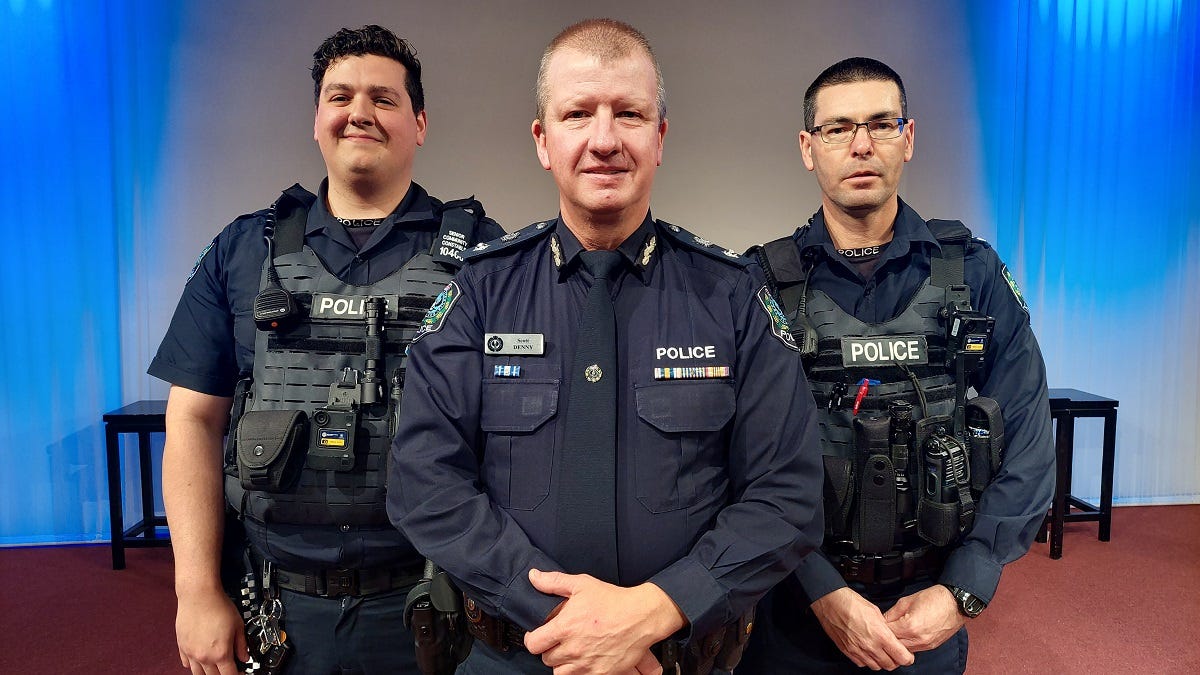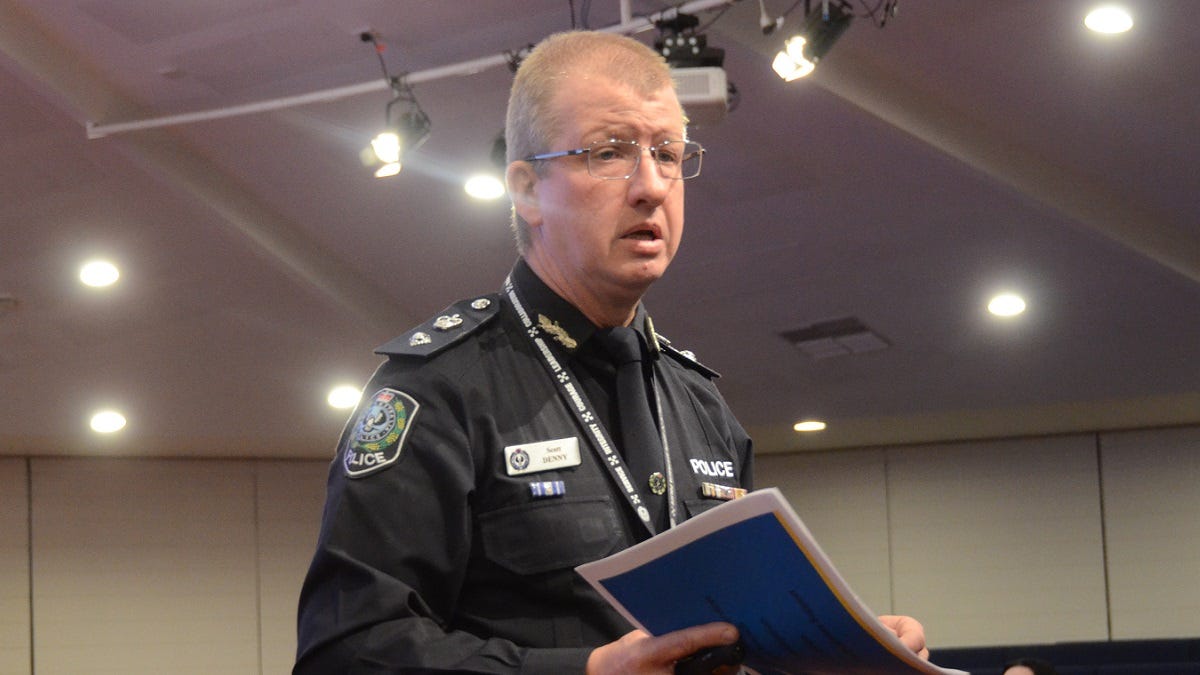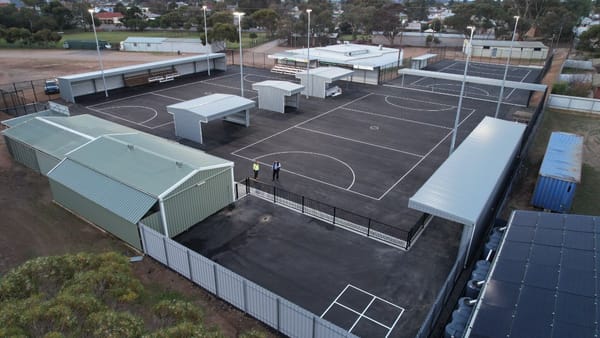Too much crime goes un-reported in Murray Bridge, police say
Murray Mallee Superintendent Scott Denny has encouraged more locals to call 131 444 if they see criminal behaviour.

This post about public safety is free to read. Please help Murray Bridge News tell more local stories by subscribing.

If you see something, say something.
That was the message from SA Police at a forum in Murray Bridge on Thursday night, where Superintendent Scott Denny said too many local crimes were going un-reported.
Unless members of the public called 131 444 to report criminal behaviour – from drug deals to dangerous driving and car park hooligans – officers’ hands were tied.
“We’re only as good as the eyes and ears of the public,” he said.
“We rely on public information.”
Even anonymous tips sent to Crime Stoppers were helpful, he said – “that’s the intelligence we need”.
Crime Stoppers CEO Nigel Smart said his organisation had helped bring 21,000 criminals to justice since 1996, and that it wasn’t finished yet.
“As a community, you can play your part,” he said.
“People in your community know stuff that’s happening, but they may not report it.”

Calling 131 444 or Crime Stoppers was the quickest way of getting information to front-line police, Superintendent Denny said.
Visiting or phoning the local station only tied up police resources.
“I’d rather have police people sitting with their backsides in the front seat of a Commodore, driving around your streets, looking for criminals,” he said.
What happens when someone makes a report to Crime Stoppers?
Superintendent Denny said reports to Crime Stoppers were sent to a senior detective from SA Police’s criminal investigation branch in Murray Bridge.
The detective checked the latest tips every morning, then allocated individual officers to investigate each one.
“‘Joe Blow in the street, I know him, he is regularly dealing drugs’ or ‘a house has cars coming and going at all hours of the night and we can smell cannabis’ or something like this ... that’s about the level of detail (we) get,” Superintendent Denny said.
“(We) might get a registration number, but generally not.”
After that, officers might drive past an address, or plain-clothes detectives might loiter nearby and watch any comings and goings, to build up a profile of regular visitors.
“Let’s face it – no-one goes into a house for 10 seconds and then walks out again,” Superintendent Denny said.
“If that behaviour’s going on, it raises suspicion.”
If an officer believed there was criminal activity at an address, he or she could ask the superintendent for a warrant to search the place.
In turn, that could lead to charges being laid, court appearances and justice being done.

Police are trained to deal with mental health episodes
Superintendent Denny defended his officers’ ability to respond to mental health incidents, including one at McDonald’s Murray Bridge in May which involved at least 15 officers.
“In that incident, (a man allegedly) turned on my officers and tried to grab a firearm; he had superhuman strength,” he said.
“We’re starting to see more of it.”
Once upon a time people with such high-level issues would have been bundled into a paddy van and taken to the old Glenside Hospital.
These days, paramedics took people to the Murray Bridge hospital for assessment.
Superintendent Denny did not believe any more specialised services were needed locally, but he noted that police training was important.
“We’ve invested a lot in training, in up-skilling,” he said.
“We’re not perfect, we’re not clinicians, but we need to have an understanding … so we’re best equipped to deal with people.”
Too many country drivers are still risking their lives
Finally, Senior Constable Brenton Lind urged motorists to – as always – take care on the road.
The number of annual deaths on South Australian roads had fallen from 349 in 1970 to around 100 in recent years, but the figures on country roads were not good enough.
In the city there were 2.2 deaths per 100,000 people each year, he said.
In the regions the figure was 10 per 100,000, and in remote areas 25.
“Small mistakes can have big consequences (on country roads),” he said.
“Take your eye off the road in the city and you might hit the gutter.
“I’ve been to several fatal accidents where people have taken their eye off the road, got down onto the dirt shoulder (and gone) sideways into a tree.”
- Report a crime: Call 131 444.
- Report lost property, a minor car accident, cyber crime or a traffic incident: www.police.sa.gov.au/online-services.
- Pass on a tip: Call 1800 333 000 or visit www.crimestopperssa.com.au.
- Crime statistics: www.police.sa.gov.au.
You can help keep local stories like this one free for everyone to read. Subscribe to Murray Bridge News today and support your independent, locally owned news service, plus get access to exclusive stories you won’t find anywhere else, from just $5 a month.





